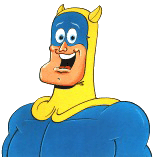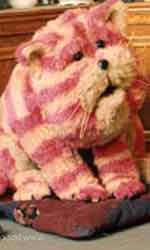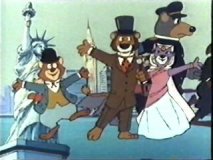Batman

BATMAN
Made by: ABC/TCF
Shown on: pretty much every terrestrial channel in the UK
Years shown: 1966 onwards
Theme Tune: “Dinna, dinna, dinna, dinna, dinna, dinna, dinna, dinna, dinna, dinna, dinna, dinna, Batman!!”
But little did his aunt know, Bruce and Dick are really the crime-fighting super duo, Batman and Robin, and below the mansion lies their Batcave, containing the clunky Bat-Computer and, of course, the Batmobile. The Dynamic Duo were always on hand to help out Police Commissioner Gordon (Neil Hamilton, although not that one unfortunately) and ‘Oirish’ Chief O’Hara (Stafford Repp) whenever they needed it, i.e. always. The Commissioner would just pick up the red Batphone, or beam the Batsignal from the top of his building, and Batman would be on the case. The secret door to the Batcave was hidden behind a bookshelf, and was opened by a switch located in a bust of Shakespeare; the pair miraculously changed into costume while sliding down the Batpoles, and would speed out of the cave. Sometimes they might be joined by Batgirl, who, unbeknown to them and to her father, was really Commissioner Gordon’s librarian daughter.
A typical day for Batman and the Boy Wonder would consist of defeating one of a number of camp and colourful villains, including Penguin (Burgess Meredith), Joker (Caesar Romero), the slinky Catwoman (Lee Meriwether/Julie Newmar), and green goblin-esque Riddler (Frank Gorshin.) Even more far-fetched additions were made to this line-up of shame, including Egghead (Vincent Price) and King Tut (Victor Buono), an Egyptology professor who was hit on the head with a rock, and as a result occasionally believes himself to be a real Egyptian pharaoh.
The hardest thing to buy into was that these pantomime criminals would manage to find a bevy of henchmen to help them in their plans of world domination. But then, these stooges were a requirement for the routine fight scenes that everyone loves. They had to be beaten to a pulp by Batman and Robin’s skilled fighting techniques, which often included hanging from chandeliers to kick people in the face, and Batman picking up Robin so he can boot someone in the chest. Marvellous. The impact of the punches and kicks were rarely seen because they were blocked out by the ‘Zap!’, ‘Sock!’, ‘Biff!’, ‘Zowie!’ signs which would flash on the screen, just to add to the delicately-crafted realism.
And if this seemed over the top, then we are forgetting many of Robin’s acute observations, which would go something like “Holy nuclear time-bomb, Batman!”, or “Holy hole in the road, Batman!” - always stating the obvious. Inevitably, the things you remember as funny as the aspects which were not supposed to be comedic: Bruce Wayne’s crap Batdancing, Adam West’s paunch, the scenes when the duo were clearly crawling across the studio floor when they were supposed to be scaling a high wall with the Batcables. But it was all great fun, and there was even a film (1966), which was mindlessly enjoyable and nothing like the recent film franchises. And I am not ashamed to admit that I had a Batman outfit when I was five, although the mask was claustrophobic and the utility-belt was a bitter disappointment. But even at that age I wondered why the so-called criminals didn’t just move to another city - providing it wasn’t Metropolis, of course.
SQUARE EYES RATING: 8/10
(Thanks to the Casual Gamers website for the borrowed pic!)



